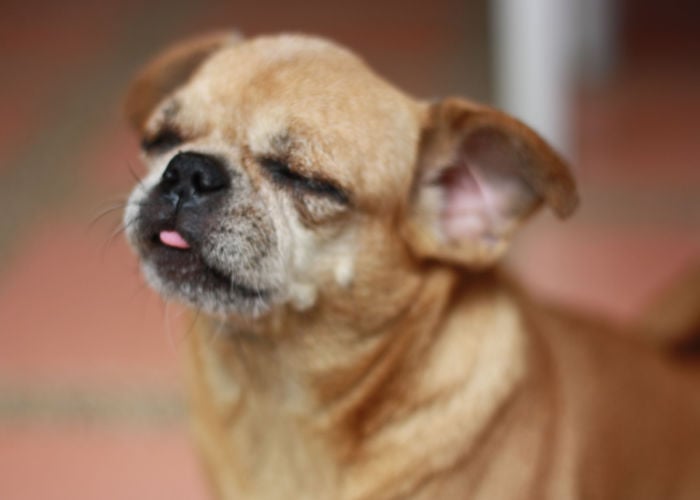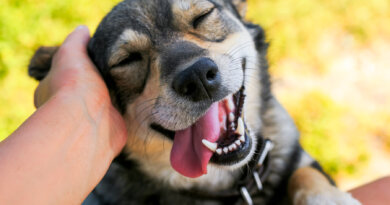Chug Dog Breed Profile – Top Dog Tips
It may seem like a Pug but why is the snout not smooshed? It must be the Chug!
Chug is the Chihuahua and Pug mix dog breed. It may look close to a Pug in terms of body features but the facial structure is greatly influenced by its Chihuahua mix.
Also known as Pugchi, Pughuahua, and Pugwawa—the Chug puppy! The great small dog with a talent for comedy, sparks of energy, and a couch potato as well. Chug is the perfect breed for those who are mostly homebodies or families.
Chug may be small but their personality is like watching an animation come to life. With such a big personality, you’ll surely fall fall for their charms.
Chug History
Chugs became popular around the early 2000s. Chugs were a result of trying to change their physical feature: a brachycephalic face to eliminate other diseases that are affiliated with it.
The Chug’s origin breed Pug and Chihuahua came from distant regions but much of their temperament is quite similar to one another. Their loyal and companionship are very much alike.
Although the Pug origin breed comes from China, which is one of the oldest breeds in existence, the Chihuahua is said to be from different origins that may have been associated with a Chinese dog breed as well.
Physical Traits
Chugs stand from 10 inches to 14 inches and can weigh from 10 to 20 pounds.
Chugs have either very short fur or medium-length fur, it may depend on which trait they may inherit from their origin breed.
Their coat can come in multiple colors from black, blue, brown, cream, and grey. Their pattern usually is in black and tan, blue and tan, brindle, liver and tan, and sable.
Like the Pugs, Chugs have the brachycephalic feature. Their face is pressed with their facial features close to each other.
Chugs’ eyes are usually black and round. Some may have their eyes bulge out a bit. Their nose is small. Chug’s muzzles are very short and round.
Chugs have a round head with their ears above eye level. Their ears flop down as well.
Their neck is thick and long that extends well to their body. Chug’s chest is not prominent but it connects well to their lower body.
Chugs have slim forelegs and hindlegs. Their tail also curves like a feather on their back.
Temperament of a Chug Dog
Chugs are quite playful and humorous. They love entertaining their humans or just spending time with them.
Chugs are great companions. They can be a chill buddy at home or someone to play with during breaks or just love doing absolutely nothing.
They’ll stick to their owner or family as they’re very loyal. They may need some supervision and introduction to children.
Chugs may have a difficult time with other dogs as they can be protective of their owner. But it doesn’t mean they won’t welcome them.
Still, they may need time and space to adjust. If they feel that their owner is safe with the other dog, they’ll eventually welcome that dog.
Chugs are great with other animals, even with cats. It’s important to introduce them properly to each other so they can establish a relationship too.
Chugs are best as home buddies. They’re flexible in home settings like in apartments or homes with or without yards but it’s important to consider their space requirement and exercise needs.
Leaving Chugs alone for long periods may cause depression and separation anxiety. Daycare or dog sit is the best option for owners if they plan to leave for long periods.
Chugs are not great with extreme weather. They should be kept inside if the weather is extremely cold or especially hot.
Chugs have inherited the vocal trait of both origin breeds, so caution for those who live in apartments with thin walls, since some Chugs are quite loud and vigilant of their territory and safety.
Training & Exercise
Chugs are quite difficult to train when they get older. It’s important to have basic training in commands while they’re young. It’s also recommended to have them socially exposed while they’re still young.
This basic training and social exposure will help them stay confident and be less wary of their surroundings.
Chugs are made to be home buddies. They do not require extensive exercise and training. For Chugs, a walk is not necessarily needed every day as they tire easily.
Playtime indoors daily and a short walk outdoors, maybe thrice a week, are enough. It’s best not to have them go outside when the weather is harsh as they are very sensitive.
Chug Health Care
Chugs are a fine breed in terms of health. Chugs can live from 10 to 15 years.
Sadly, some Chugs may suffer some diseases that are congenital and often due to irresponsible breeding. Here are several diseases owners should look out for:
Atopic Dermatitis
Atopic Dermatitis is the condition in which allergens in the surroundings, either inhaled or through contact, cause allergic reactions on the skin.
It may be difficult to determine what particularly stimulates the allergy but the effect in Chugs is usually found in the folds of their skin since most Chugs inherit the saggy skin of the Pug.
It’s important to address the allergy for it may lead to other infections if left as is.
Consulting with the veterinarian may help address the problem and determine what particularly triggered the allergic reaction.
Owners should have their Chug checked immediately if symptoms appear.
Brachycephalic Facial Structure
Some Chugs are Brachycephalic dogs, which is a physical trait of a Pug. Some Chugs may have flatter faces than others.
They have short noses and elongated palates that can cause breathing problems.
Chugs may have trouble breathing during warm weather. They may require surgery to broaden their nostrils.
Progressive Retinal Atrophy
Progressive Retinal Atrophy is a degenerative disease that affects the rod and cone cells in the eyes that leading to blindness.
It is an inherited disease and it’s known to have no treatment. It can progress quickly from a year or two.
Have your Chug checked regularly to guarantee less risk to their health.
Food Obsession or Pica
Some dogs, including Chugs, have the habit of wanting to eat all the time. Even after meals, they will find their way to get into food or anything they find edible.
Some dogs have their pro-opimelanocortin (POMC) gene, which is a gene that modulates a dog’s appetite once it’s adequately mutated.
Instead of their brain signaling that the food they had intake is sufficient, it is nonfunctional.
Food obsession can develop behavioral and medical issues if not dealt with properly and immediately. Owners can also find ways so their Chugs do not guzzle on their food at home.
Owners can create a calmer environment during meal time for their Chugs or find ways to avoid food guzzling.
Hip Dysplasia
Hip dysplasia is a genetic condition wherein the socket of the joint and ball becomes distorted.
When diagnosed with hip dysplasia, it’s important to keep their weight in the normal range and have them exercise with activities that promote joint therapy.
Veterinarians may prescribe medications for anti-inflammatory/ pain relievers and supplements. Prevention is the same, keeping them active but not injuring them as well.
A treadmill walk or swimming is perfect for prevention and recovery as well.
Nerve Degeneration
Degenerative Myelopathy is a disease that affects the spinal cord and results in weakness and paralysis.
Although the causes are unknown, Chugs with degenerative myelopathy usually inherit it from their dam or sire. This is both present in both origin breeds as well.
It usually appears around 4 years old of age early to 10+ years latest. Although there is no definite treatment, veterinarians usually address the other lying conditions that come with it (hip dysplasia or arthritis).
Keeping the Chug’s health in great condition also helps prolong its life. It’s best to have the Chug’s tested for any suspected degenerative myelopathy symptoms.
Obesity
Chugs are quite big eaters for their size. It’s best to watch out for what they eat and how much as well. It’s important to provide a diet compatible with their size.
If they are heavy eaters, it’s best to provide meals split at least thrice or four times a day with the usual amount. Obesity in small breeds can lead to further health implications that may lower the quality of their life.
Patellar Luxation
Patella Luxation is the patella shifting alignment out of the femur. This can range from high to low levels of luxation, and each requires different treatments.
Symptoms may include skipping and kicking off the leg. It’s best to consult with the veterinarian for treatments, therapies, or procedures required to help Chugs with this condition.
Owners should keep in mind the condition of their Chugs. Chugs are not relatively new but since mixed breeds are still on the lookout in the health department, it’s not easy to address complications unlike in pure breeds.
If people are looking for Chug dog breeds, they should always go to a professional or a reputable breeder instead of buying from puppy mills.
Dogs from these places are often not tested before breeding, causing the dog to suffer diseases that could have been avoided beforehand.
Diet of the Chug Dog Breed
Chugs may be small dogs but their appetite is quite big. It’s important to provide them with meals that are heavy but not huge in quantity, as this may help less the risk of obesity.
Chugs can be given high-quality dry food or wet food, or better mixed in adequate amounts only. About 1 or 2 cups of meal a day, divided into three or four, is a great way to serve their meal.
If they can consume food slowly multiple times a day, they will likely guzzle their food in the future, as they feel filled for hours.
A lot of Chugs are food greedy, so owners can find ways to slow down their eating or stop food guzzling altogether with different instruments.
When training, they can be motivated by the treats given. Owners should watch out how much they give as well, as treats bought from stores may have large amounts of calories.
Grooming
Chugs have a moderate grooming level. Of course, it will depend on the type of fur they have inherited from their origin breed.
Most chugs inherit the short and coarse fur of Pugs but some Chugs may have inherited a medium coat due to their Chihuahua breed.
Brushing
But most Chugs have the wrinkly look as well. Their wrinkly look, like the Pug, has a short coat.
It may shed quite a lot. Brushing them at least twice or thrice a week can help with the shedding.
The same goes for the longer-length furs in Chugs. Brushing twice or thrice a week can help eliminate dead hair, making room for a healthier coat.
Brushing their coat helps distribute natural oils throat their body which is healthy for their skin as well.
It’s also best to brush their shedding fur before it clutters around the home.
Bathing
Chugs should be bathed at least twice to three times a month. Bath is especially needed after an activity that gets them grubby and grime. It’s good to wipe their paws after an outdoor activity too.
Chugs should be dried well after every bath, especially through every spot of the fold.
These folds barely move on their own so grime and moisture may build up. Similar to Pugs, Chugs are prone to several skin infections. Build-up can cause hot spots or infections.
Ears
Chug’s ears must be dried after every bath. It’s best to clean it at least once a week. Since their ears flap down, helping them dry them out can help them dry faster. Inside as well.
Do not leave the ears moist as it may result in infection and may damage the inner ear canal.
Nails
Chug’s nails should be trimmed at least once every two weeks. It’s best to keep their nails short as it may cause discomfort.
The nails aren’t necessarily needed to be trimmed. It can be filed instead as well, especially if it’s not that long.
Teeth
Chug’s teeth must be brushed regularly as well as they are prone to dental issues if left as is.
Providing soft and chewy diets can also help stimulate movement in their teeth and gums which is good for them.
Owners should not forget to include brushing their teeth as part of the grooming.
Chugs should be introduced to grooming routines at a young age for an effortless and comfortable experience for both the pet and owner. It’s best to introduce these activities at a young age.
Chugs don’t drool despite their short snout. So it’s not necessary to bring a towel to wipe their mouths now and then.
Chug Dogs: Frequently Asked Questions
What size is a Chug dog breed?
Chug mixed dog breeds are in the small category of dog breeds. Chug’s origin breed is found in both the small category too.
They stand from 10 to 15 inches in height. Their small stature makes them the perfect lap dog.
Is training a Chug hard?
Yes, Chugs may be difficult to train, especially when they have reached adulthood. That’s why it’s highly recommended to have them exposed early to a variety of people, animals, places, and situations.
It’s also best to get them basic training while they are young as they will become stubborn over time.
Are Chugs healthier than Pugs?
There’s still no definite answer for this. Since Chugs are relatively new, most of their inherited disease came from either the Pug or Chihuahua breed.
This makes it hard to determine if they are healthier than the Pug breed.
Although Chugs were made to eliminate the brachycephalic feature, Chugs are still prone to respiratory issues since the condition is still present.
Chug Dog Breed Profile Summary
The Chug is the perfect fur buddy for you if you love a dog you could stay with you all the time, just chatting on the couch, watching tv, or a brisk walk to freshen up.
Chugs will stay by your side and would love to be part of your every day.
Chugs may still have bits of essentials they need, so as long as this is well provided, there won’t be many problems owners would be facing.
As long as their vaccine is up-to-date, they have a well-balanced diet, are mentally and physically stimulated, paid attention to, and have their needed exercise, it’s a smooth sail from there.
If adopted from a reputable breeder, Chug puppies will be less likely to have any health disorders.
If the owner ever plans to adopt from somewhere else, we highly recommend having it checked and tested with the veterinarian as soon as possible.
Please avoid buying dogs from puppy mills or irresponsible breeders as they breed dogs without regard to the consequences of ruthlessly breeding without testing dogs beforehand.
Love more Pug mixed dog breeds? You might want to check out the next article!
RELATED: PUGGLE DOG BREED PROFILE
Related









